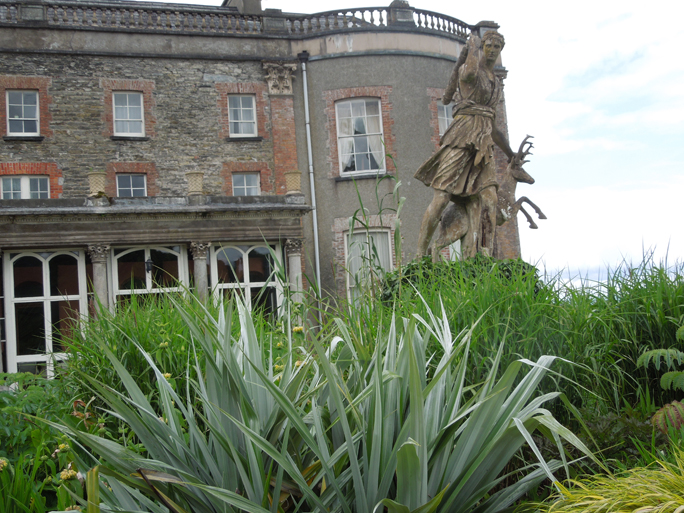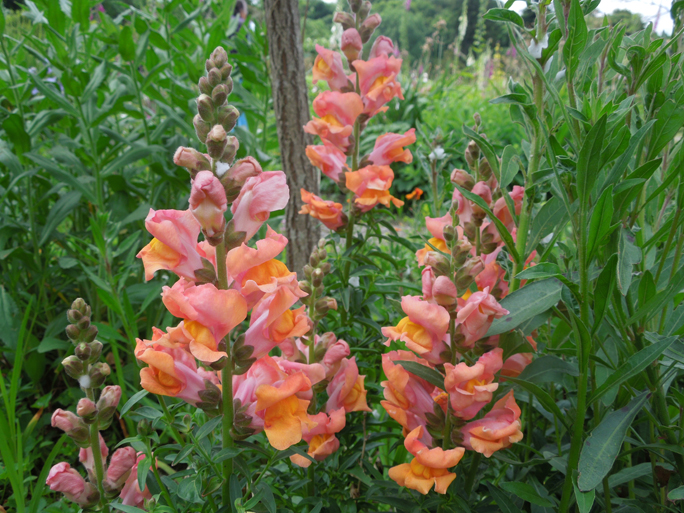BANTRY HOUSE AND GARDEN
Visited on June 13, 2012
With members of the Lakeland Horticulture Society
Bantry Bay on the southwest coast of Ireland is a deep natural harbor where the Atlantic Ocean waters are warmed by the Gulf Stream creating a seaside climate that allows a variety of temperate plants to thrive at the gardens of Bantry House.

The base for the LHS southwest tour was the Castle Hotel in the market town of Macroom, a short distance from Cork. It was late afternoon when we checked into the hotel and I was anticipating the next three days of visits to private and public gardens of West Cork.

Our first garden on the Wednesday itinerary was at Bantry House. The drive by coach to Bantry was on a country road past quiet lakes of Gougane Barra where the clear waters reflected the blue of the morning sky. Swans in pairs glided near the shoreline. Wild purple digitalis grew in large swatches along side the roadway and merged into the countryside. Rustic farmhouses set far back from the road were scattered far between each other. Herds of black and white spotted dairy cattle browsed in pastures with sheep grazing on grass close to the farm barns. In the far distance the farmland merged into swatches of mature pine trees at the foot of grass-covered hillsides.

It was a short distance past the fishing port town named Bantry to Bantry House, a Georgian brick mansion from the 1750’s named after the 1st Earl of Bantry. It is still owned and occupied by descendants of that family. It was the 2nd Earl of Bantry Richard White, who after traveling extensively in Europe from 1820-1840 rebuilt the house with seven terraces, (the house on the third) based on the Italian and French estates and gardens that he had visited.

The gardens, originally a status statement reflecting the wealth and taste of the Bantry family, were neglected in the 1930’s. In 1997 restoration of the gardens began and are still continuing based on the 2nd Earl’s original gardens.

An unobstructed view of the calm water of the bay with a scattering of sailboats moored near the shore and the silhouette of the Caha Mountain range on the opposite side of the Atlantic Ocean, was our introduction to the Bantry House Estate.

Near the east entrance to the mansion is a tall statute of Diana, the Roman Goddess of woodlands and hunting, centered in a circular bed of informal plantings of perennials.

As we gathered around the circular bed of grasses and silver astelia on the manicured French styled lawn, the head gardener told us that no chemicals are used on the grounds. They do garden organically as much as possible. We noticed a nearby gardener using a foliage spray of seaweed on nearby plantings.

Completing the picturesque landscape are fourteen circular low growing, formal box hedges alternately filled with golden daylily or Russian Sage.


Classical statutes and urns that the Earl had collected on his continental travel are displayed symmetrically on each side of a wide pathway that leads to balustrades encircling the lawn with the broad Atlantic waters beyond the bay.

On the west side of the house is the Sunken Rose Garden where an impressive Cordyline australis dominated the view.

The garden showcased a variety of temperate plants, hardy perennials and a scattering of annuals sharing space with roses.



The sturdy spires of digitalis were scattered throughout the garden and Agapanthuses were thriving in this seaside climate. The annual sweet pea mingled with the hardy perennials.



The south side of the house continues with the four remaining terraces. The pathway through the parterre garden of 64 beds of formal yew and box hedges led to an elevated 200 year old Wisteria which formed a circle around a water fountain in the center.


A staircase made of local stone leads one hundred steps up a steep climb with azaleas and rhododendron on either side of the hillside. Clear weather provided us with an unobstructed and a dramatic view across the Bay to the Caha Mountain in Kerry.

A path at the top of the climb leads away from the formality of the house gardens to the woods with a red Japanese style bridge over a small stream. Ferns, ivy and invasive Gunnera manicata cover the slope of the woodland hillside. Bordering the woods a few azaleas bushes with pink spring blossoms were still in bloom. The pathway ended at a walled garden under restoration which is currently used for growing vegetables.

A light lunch in the Bantry House tearoom was the closing of our visit to 45 acres of continental gardens situated along the Irish seacoast. We boarded the coach for the drive to Glengariff where a ferry would transport us to Ilnacullin, an island in Bantry Bay where the gardens also depends on the warmth of Gulf Stream currents.

Photos by Deborah McMillin